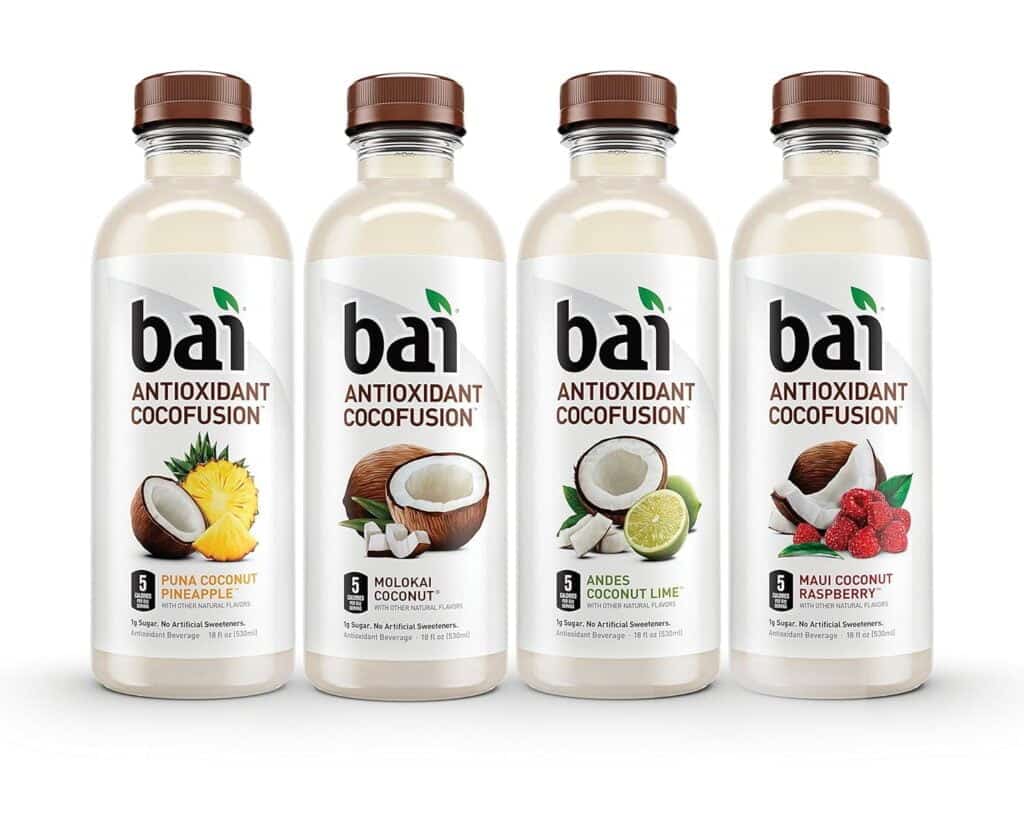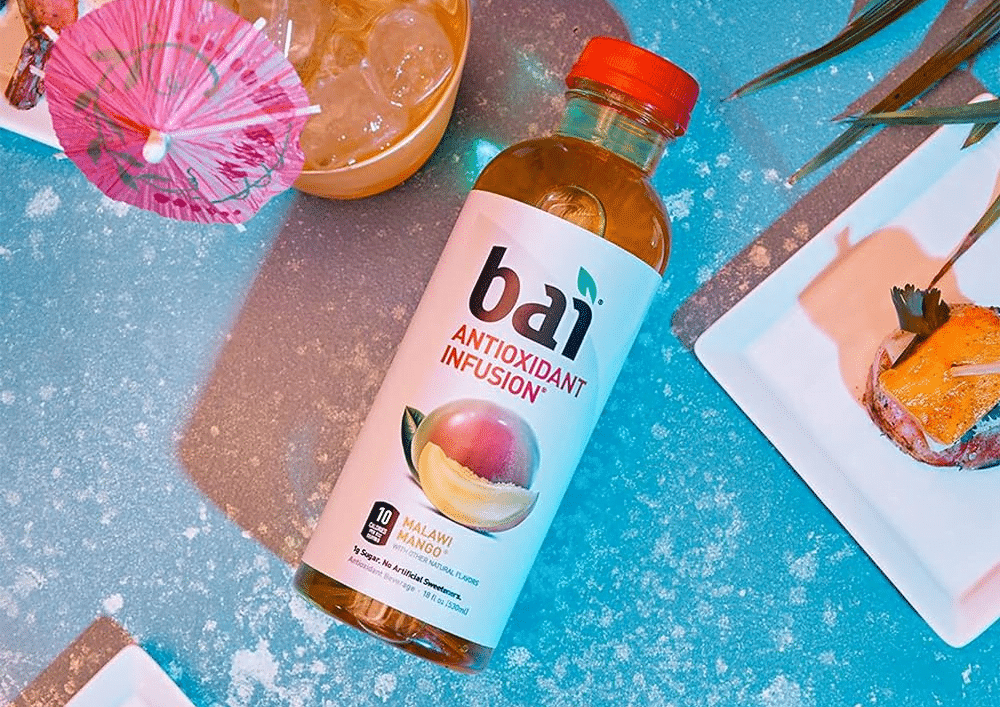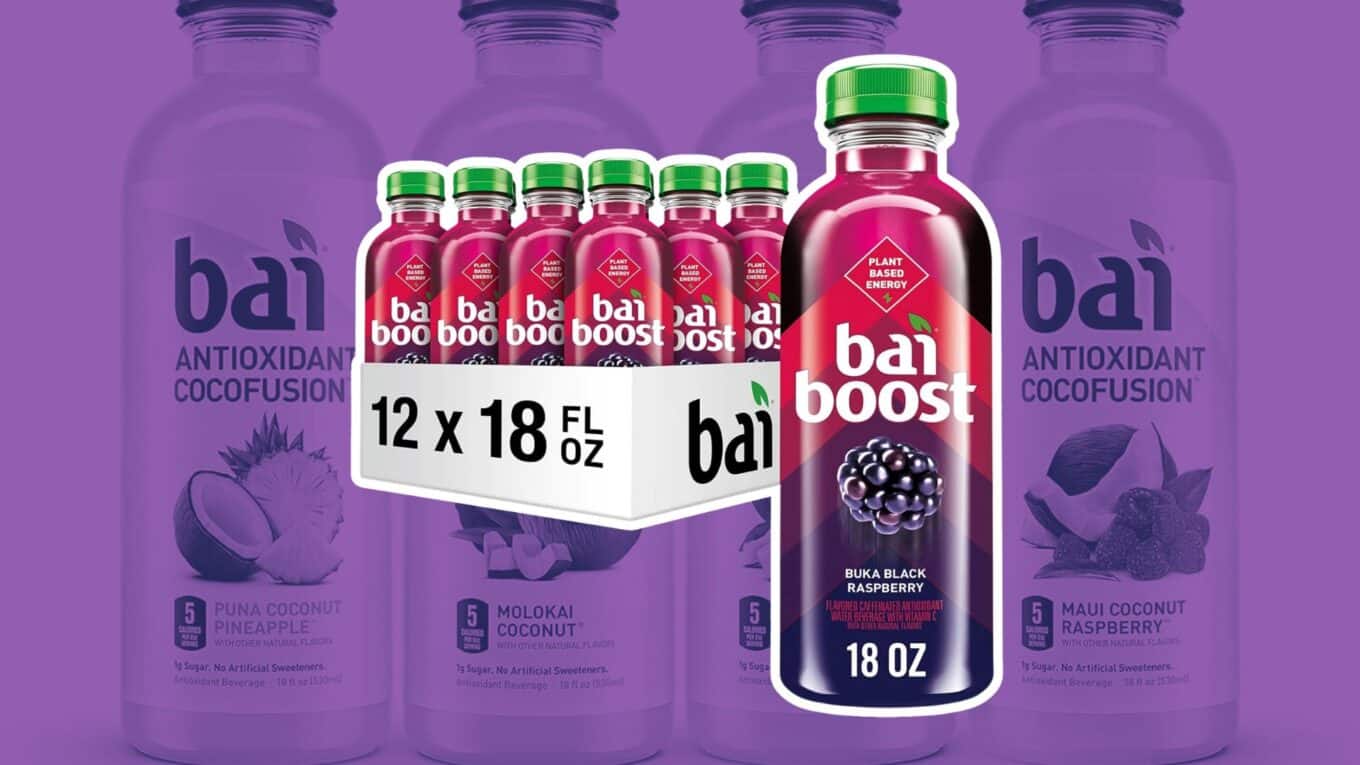Many of us are searching for tasty, low-calorie drink options in today’s health-conscious world.
Bai beverages have become a seemingly healthy alternative to sugary sodas and juices.
In this comprehensive review, we’ll look at the science behind Bai drinks to help you decide if they’re a smart choice for your lifestyle.
We’ll explore the key ingredients, examine the potential benefits and drawbacks, and provide the information you need to make an informed decision.
By the end of this article, you’ll clearly understand whether Bai beverages are a healthy addition to your diet or if better alternatives are available.
So, let’s dive in and uncover the truth about these trendy drinks.
Composition of Bai Beverages

Bai drinks are known for their unique blend of ingredients, each offering its potential health benefits.
1. Key Components
The key components in most Bai beverages include coffee fruit extract, tea extracts (white, green, and black), erythritol, stevia leaf extract, natural flavors, and fruit juice concentrates.
2. Coffee Fruit Extract
Coffee fruit extract, derived from the outer part of the coffee bean, is a rich source of antioxidants.
These antioxidants may help support brain health by increasing brain-derived neurotrophic factor (BDNF) levels and protecting against oxidative stress, which is linked to various neurodegenerative diseases.
3. Tea Extracts
Bai also incorporates tea extracts from white, green, and black teas, each offering unique antioxidants and health benefits. For example:
- Due to its high polyphenol content, white tea extract has been associated with anti-aging properties and potential cancer and heart disease prevention.
- Green and black tea extracts may also provide anti-carcinogenic effects and support overall well-being.
4. Natural Sweeteners
Bai uses natural sweeteners like erythritol and stevia leaf extract to keep the calorie count low while maintaining sweetness.
- Erythritol is a sugar alcohol that contains significantly fewer calories than sugar, while stevia, derived from the stevia plant leaves, is much sweeter than sugar.
- However, some people may experience digestive discomfort when consuming these sweeteners in large quantities.
5. Natural Flavors and Fruit Juice Concentrate
- Lastly, natural flavors and fruit juice concentrates are added to enhance the taste and appeal of Bai beverages.
- While these ingredients contribute to the flavor profile, they offer minimal nutritional value and sometimes involve processing methods that may diminish their potential health benefits.
Nutritional Analysis of Bai Beverages
| Aspect | Key Details |
|---|---|
| Popularity | Low calorie, low sugar, popular with health-conscious consumers |
| Nutritional Content | 10 calories, 2 grams of sugar per 16-ounce bottle |
| Antioxidant Content | Extracts from coffee, fruit, and tea |
| Potential Benefits | Antioxidants may help reduce oxidative stress |
| Sweeteners | Erythritol and stevia (may cause digestive and gut issues) |
| Missing Nutrients | Lacks essential fibers and nutrients |
| Conclusion | Not a substitute for a balanced diet |
1. Nutritional Content
- A typical 16-ounce bottle contains only 10 calories and 2 grams of sugar, making it an attractive choice for those seeking to reduce their calorie intake.
- This is a significant advantage over traditional sugary drinks like sodas, which can contain up to 40 grams of sugar per 12-ounce can.
2. Antioxidant Content
One of Bai drinks’ main selling points is their antioxidant content derived from coffee, fruit, and tea extracts.
These antioxidants help protect the body against oxidative stress linked to various health issues, such as inflammation, premature aging, and chronic diseases.
By incorporating these extracts, Bai offers potential health benefits beyond just hydration.
3. Non-Nutritive Sweeteners
However, it’s important to note that Bai relies on non-nutritive sweeteners like erythritol and stevia to achieve its low-calorie profile. While these sweeteners don’t contribute to the calorie count, they may have some drawbacks:
- Some studies suggest that consuming large amounts of erythritol can lead to digestive issues, such as bloating and discomfort.
- Research has shown that even in low doses, stevia may disrupt the gut microbiome, which could negatively impact overall health.
4. Missing Nutrients
Moreover, Bai beverages contain some beneficial ingredients but lack the essential fibers and nutrients in whole, unprocessed foods.
The heavy processing required to create these drinks can strip away some of the nutritional value of some of the natural ingredients.
Consequently, consuming Bai should not be considered a substitute for a balanced diet rich in whole fruits, vegetables, and other nutrient-dense foods.

Bai beverages offer a mix of potential health benefits and risks, making it essential to weigh the pros and cons before incorporating them into your diet.
1. Pros
On the positive side, drinking Bai can improve your daily hydration needs.
- Proper hydration is crucial for maintaining various bodily functions, such as regulating body temperature, supporting digestion, and promoting skin health.
- The antioxidants found in the coffee fruit and tea extracts used in Bai drinks may help combat oxidative stress, which has been linked to numerous chronic diseases, including heart disease and certain cancers. However, the non-nutritive sweeteners used in Bai beverages, like erythritol and stevia, may pose health concerns.
2. Cons
- While they help keep the calorie count low, these sweeteners can cause digestive issues, such as bloating, gas, and diarrhea, especially in individuals sensitive to sugar and alcohol.
- Furthermore, some studies suggest that even low doses of stevia may negatively impact gut health by disrupting the delicate balance of the gut microbiome.
- Another factor to consider is Bai beverages’ environmental impact. The drinks are packaged in plastic bottles, contributing to the growing plastic waste problem.
- If not properly recycled, these bottles can end up in landfills or pollute the environment, harming wildlife and ecosystems.
Comparative Analysis with Other Beverages
| Aspect | Key Details |
|---|---|
| Comparison to Sugary Drinks | – Sodas (12 oz can): 150 calories, 40 grams sugar |
| – Bai (16 oz bottle): 10 calories, 2 grams sugar | |
| Unique Ingredients | – Sweeteners: Stevia, erythritol |
| – Antioxidants: Coffee, fruit and tea extracts | |
| Comparison to Other Alternatives | – Stands out due to a unique blend of natural ingredients |
| Market Positioning | – Low-calorie, antioxidant-rich profile |
| – Attracts health-conscious consumers | |
| Market Impact | – Growing popularity due to health-focused branding |
Compared to traditional sugary drinks and sodas, Bai beverages offer a significantly lower calorie and sugar content.
- Regular sodas often contain high amounts of processed sugars, with a 12-ounce can typically pack 150 calories and 40 grams of sugar.
- In contrast, a 16-ounce bottle of Bai has just 10 calories and 2 grams of sugar.
This substantial difference in sugar and calorie content makes Bai a more appealing choice for those looking to reduce their intake of these potentially harmful ingredients, which have been linked to health issues like obesity and diabetes.
In the landscape of healthier beverage alternatives, Bai positions itself as a more health-conscious option due to its use of natural sweeteners like stevia and erythritol and its infusion of antioxidants from coffee, fruit, and tea extracts.
- Compared to other popular choices like infused waters, herbal teas, and pure fruit juices, Bai stands out for its unique blend of ingredients and potential health benefits.
However, it’s important to note that while pure fruit juices contain natural sugars and nutrients, they also tend to be higher in calories than Bai.
- From a market positioning perspective, Bai leverages its low-calorie, antioxidant-rich profile to attract health-conscious consumers seeking refreshing beverages that can be part of a healthy lifestyle without the detrimental effects of traditional sodas’ high sugar content.
- The brand’s marketing strategies and overall image align with current health trends, emphasizing the importance of making better choices for well-being.
This approach has helped Bai establish a strong presence in the beverage market and contributed to its growing popularity among consumers who prioritize their health.
Conclusion
In conclusion, Bai beverages offer a unique blend of natural ingredients and potential health benefits that appeal to health-conscious consumers seeking alternatives to sugary drinks.
While the low calorie and sugar content and the presence of antioxidants from coffee, fruit, and tea extracts position Bai as a healthier choice, it’s important to consider the potential drawbacks of non-nutritive sweeteners and the environmental impact of plastic packaging.
As with any packaged beverage, consuming Bai should be done in moderation as part of a balanced diet.
By prioritizing transparency and accuracy in its marketing claims and continuously improving its products based on scientific research and consumer feedback, Bai can strengthen its brand reputation and maintain its position as a popular choice in the healthy beverage market.




